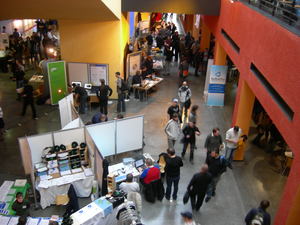Friday, May 16. 2008
Wir hassen teuer
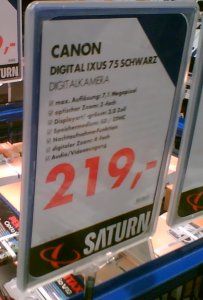 Zugegebenermaßen ist die Erkenntnis, dass die so genannten Elektronik-Discounter mit ihren Werbeaussagen ob ihrer Preisgünstigkeit manchmal leicht daneben liegen, keine sonderlich neue.
Zugegebenermaßen ist die Erkenntnis, dass die so genannten Elektronik-Discounter mit ihren Werbeaussagen ob ihrer Preisgünstigkeit manchmal leicht daneben liegen, keine sonderlich neue. Dieses Beispiel fand ich jedoch schon extrem (das zweite Bild ist ein Screenshot von cyberport.de).
Dieses Beispiel fand ich jedoch schon extrem (das zweite Bild ist ein Screenshot von cyberport.de).
Wednesday, May 7. 2008
OpenStreetMap im Spiegel
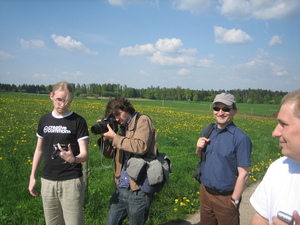 Wir (OpenStreetMap-Lokalteam Murrhardt/Sulzbach) hatten gestern Besuch vom Spiegel. Zwei sehr engagierte Journalisten begleiteten uns bei einer Mapping-Tour.
Wir (OpenStreetMap-Lokalteam Murrhardt/Sulzbach) hatten gestern Besuch vom Spiegel. Zwei sehr engagierte Journalisten begleiteten uns bei einer Mapping-Tour.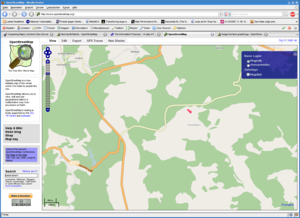 Um den Mapper-Erfolgseffekt möglichst gut darzustellen, suchten wir uns einen Ort, in dem noch fast nichts gemappt war (Kaisersbach). Das Ergebnis kann man dann hier bewundern.
Um den Mapper-Erfolgseffekt möglichst gut darzustellen, suchten wir uns einen Ort, in dem noch fast nichts gemappt war (Kaisersbach). Das Ergebnis kann man dann hier bewundern.Ich hab ein recht gutes Gefühl, Interesse und Kompetenz schien vorhanden, es wurden nicht die üblichen »dummen« Fragen gestellt (»Warum macht ihr das, Google Maps ist doch auch kostenlos?«) und es war eine sehr angenehme Atmosphäre. Wann der Artikel erscheint wissen wir noch nicht, werde ich dann rechtzeitig mitteilen.
Wednesday, April 23. 2008
Free software for your canon camera (CHDK)
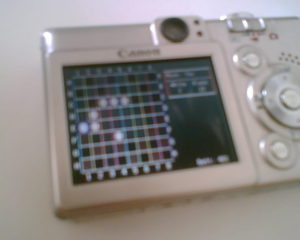 I own this Canon IXUS 50 camera for more than two years now. It's a fine device, but it has some small lacking features where I often asked myself if this could be enhanced with a new firmware.
I own this Canon IXUS 50 camera for more than two years now. It's a fine device, but it has some small lacking features where I often asked myself if this could be enhanced with a new firmware.Until recently, when I read about the CHDK project: It's a kind of firmware enhancements for Canon cameras. It doesn't fully replace the real firmware, but adds additional stuff (I must say I don't fully understand what they do). And now they have an experimental port for the SD400, which is built into my cam.
The first big killerfeature one will notice is that the cam now has a battery monitor, which is the most obvious lacking feature of the original firmware.
One more thing I always would've liked for my cam is a better video compression. The video quality is quite good, but the cam just can do mjpeg, which leads to big files and limits your maximum video size to about 20 minutes. It seems CHDK has some better compression video mode, but I'll have to dig deeper into it. Beside, I can now record raw images. So there's lot's of cool stuff to play with.
Monday, April 21. 2008
ping with IDN
 Today I asked myself if I can ping an IDN host.
Today I asked myself if I can ping an IDN host.My default ping (iputils on linux) couldn't do it, but I found some patches out there, e.g. from Fedora. Thanks to SpanKY, we now also have IDN-enabled ping in Gentoo (he used a modified patch).
Posted by Hanno Böck
in Computer culture, English, Gentoo, Linux
at
01:26
| Comments (2)
| Trackbacks (0)
Thursday, April 10. 2008
Wordpress mass hacks for pagerank
Today heise security brought a news that a growing number of old wordpress installations get's misused by spammers to improve their pagerank. I've more or less waited for something like that, because it's quite obvious: If you have an automated mechanism to use security holes in a popular web application, you can search for them with a search engine (google, the mighty hacktool) and usually it's quite trivial to detect both application and version.
This isn't a wordpress-thing only, this can happen to pretty much every widespread web application. Wordpress had a lot of security issues recently and is very widespread, so it's an obvious choice. But other incidents like this will follow and future ones probably will affect more different web applications.
The conclusion is quite simple: If you're installing a web application yourself, you are responsible for it! You need to look for security updates and you need to install them, else you might be responsible for spammers actions. And there's no »nobody is interested in my little blog«-excuse, as these are not attacks against an individual page, but mass attacks.
For administrators, I wrote a little tool a while back, where I had such incidents in mind: freewvs, it checks locally on the filesystem for web applications and knows about vulnerabilities, so it'll tell you which web applications need updates. It already detects a whole bunch of apps, while more is always better and if you'd like to help, I'd gladly accept patches for more applications (the format is quite simple).
With it, server administrators can check the webroots of thier users and nag them if they have outdated cruft laying around.
This isn't a wordpress-thing only, this can happen to pretty much every widespread web application. Wordpress had a lot of security issues recently and is very widespread, so it's an obvious choice. But other incidents like this will follow and future ones probably will affect more different web applications.
The conclusion is quite simple: If you're installing a web application yourself, you are responsible for it! You need to look for security updates and you need to install them, else you might be responsible for spammers actions. And there's no »nobody is interested in my little blog«-excuse, as these are not attacks against an individual page, but mass attacks.
For administrators, I wrote a little tool a while back, where I had such incidents in mind: freewvs, it checks locally on the filesystem for web applications and knows about vulnerabilities, so it'll tell you which web applications need updates. It already detects a whole bunch of apps, while more is always better and if you'd like to help, I'd gladly accept patches for more applications (the format is quite simple).
With it, server administrators can check the webroots of thier users and nag them if they have outdated cruft laying around.
Posted by Hanno Böck
in Computer culture, English, Linux, Security
at
02:44
| Comment (1)
| Trackbacks (0)
Monday, April 7. 2008
Augsburger Allgemeine schreibt über Linux-Infotag
Und erwähnt mich. Zitat:
Hanno Böck, der die freie Geodatenbank Openstreetmap vorstellte, war extra nach Augsburg gereist, da es »hier noch besonders viel zu tun gibt«. Ein Blick auf eine Augsburger Stadtkarte zeigte, was er meint: Einige Straßen sind schon drin, Bahnlinie und Hauptbahnhof auch, sogar Sträßchen wie Kappelberg, Milchberg, Bäckergasse und Hallstraße sind eingezeichnet. Aber wo ist die Maximilianstraße? Der Rathausplatz? Da sieht es doch recht leer aus.
Augsburger Allgemeine: Damit der PC mit seinem Nutzer rechnen kann
Hanno Böck, der die freie Geodatenbank Openstreetmap vorstellte, war extra nach Augsburg gereist, da es »hier noch besonders viel zu tun gibt«. Ein Blick auf eine Augsburger Stadtkarte zeigte, was er meint: Einige Straßen sind schon drin, Bahnlinie und Hauptbahnhof auch, sogar Sträßchen wie Kappelberg, Milchberg, Bäckergasse und Hallstraße sind eingezeichnet. Aber wo ist die Maximilianstraße? Der Rathausplatz? Da sieht es doch recht leer aus.
Augsburger Allgemeine: Damit der PC mit seinem Nutzer rechnen kann
Sunday, March 30. 2008
Linux-Infotag Augsburg
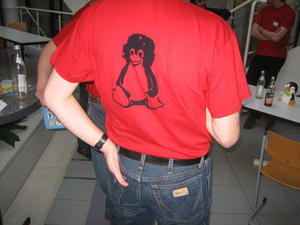 Gestern war ich auf dem Augsburger Linux-Infotag. Ein kleines, aber feines Linux-Event für den im Moment etwas unterrepräsentierten süddeutschen Raum.
Gestern war ich auf dem Augsburger Linux-Infotag. Ein kleines, aber feines Linux-Event für den im Moment etwas unterrepräsentierten süddeutschen Raum.Mein OpenStreetMap-Vortrag wurde von knapp 50 Menschen besucht und lief ganz passabel. Erste Spuren in der bislang etwas vernachlässigten Augsburger Innenstadt sind schon sichtbar (Slides wie üblich hier, aber kaum verändert zum letzten Mal).
Am CAcert-Stand war man optimistisch, dass noch (Zitat) »dieses Frühjahr« die Firefox-Integration klappt (aber das habe ich schon oft gehört...), die Freifunker in Augsburg sind nett, PacketRadio und Amateurfunk taugt nicht für Freifunk (due to Gesetz, welches den Content einschränkt) und insgesamt war es ein nettes Event. Ich denke nächstes Mal bin ich wieder dabei.
Bilder vom Linux-Infotag Augsburg gibt's hier.
Wednesday, March 19. 2008
Die Speicherung ist das Problem, nicht der Abruf
Das Bundesverfassungsgericht hat zur Vorratsdatenspeicherung gesprochen. Leider alles andere als positiv. Was ich befürchtet habe, ist eingetreten, wie schon bei der Onlinedurchsuchung oder der Kennzeichenerfassung sprach das höchste Gericht einen faulen Formelkompromiss. Allerdings ist dieser noch deutlich fauler als die bisherigen.
Auch wenn der AK Vorrat selbst dies als Sieg verkaufen will, ich sehe das deutlich anders und versuche darzulegen wieso.
Kurz gesprochen lautet die Entscheidung: Gespeichert wird weiterhin, einzig der Abruf bleibt auf schwere Straftaten beschränkt. Eine endgültige Entscheidung gab es noch nicht, diese wird erstmal auf die lange Bank geschoben, insofern ist natürlich jede Einschätzung nicht endgültig und ich widerrufe alles hier gesagte, sollte das BVerfG. in absehbarer Zeit weiteres entscheiden.
Das Kern des Problems: Das BVerfG. sieht einen schwerwiegenden Grundrechtseingriff erst beim Abrufen der Daten, insofern beschränkt es diese auf schwere Verbrechen. So interpretiert etwa ein ARD-Rechtsexperte:
»Dass die Verbindungsdaten bis auf weiteres sechs Monate lang gespeichert - allerdings nicht ausgewertet - werden. Es sei denn, der Bürger gerät in Verdacht, eine schwere Straftat begangen zu haben. Dann muss ein Richter anordnen, dass die Verbindungsdaten den Ermittlern zugänglich gemacht werden.«
Das ist nun aber, gelinge gesagt, völliger Blödsinn. Es macht nur dann Sinn, wenn man davon ausgeht, dass ein Mißbrauch der Daten prinzipiell auszuschließen ist. Angesichts der Häufigkeit, in der gehackte Foren, größere Kundendaten von Unternehmen etc. immer mal wieder auftauchen, kann das nur glauben, wer die Realität vollkommen ausblendet.
Genau aus diesem Grund spricht man bei sinnvollem Datenschutz vom Konzept der Datensparsamkeit: Daten, die nicht erhoben werden, können auch nicht mißbraucht werden. Wenn sensible Daten erhoben werden, werden sie genutzt, mit hoher Warscheinlichkeit auch außerhalb ihrer ursprünglichen Zweckbestimmung. Dass das BVerfG. den Grundsatz der Datensparsamkeit mit seiner Entscheidung offensichtlich nicht beachtet, das ist das traurige an der heutigen Entscheidung.
Für die »Datenschutzbewegung«, den AK Vorrat und andere, stellt sich hier natürlich eine nicht unkritische Strategiefrage. Bislang galt das BVerfG. immer als letzte Hoffnung für den Datenschutz (was ja in mehreren Fällen der Vergangenheit durchaus berechtigt war). Meiner Ansicht nach täte nach dieser Entscheidung eine kritischere Haltung dem höchsten Gericht gegenüber Not. Das dies nicht einfach ist, als gesellschaftlich zwar wachsende aber immer noch schwache Strömung, die die große Mehrheit beider Volksparteien gegen sich hat, versteht sich.
(Hier stand noch ein Satz mit Link zu dieser Meldung, wo ich aber zugegebenermaßen unsauber recherchiert habe: Die Meldung ist zwei Jahre alt und wurde längst dementiert.)
Update: Bei den Piraten sieht man das Urteil ähnlich kritisch, lesenswert.
Auch wenn der AK Vorrat selbst dies als Sieg verkaufen will, ich sehe das deutlich anders und versuche darzulegen wieso.
Kurz gesprochen lautet die Entscheidung: Gespeichert wird weiterhin, einzig der Abruf bleibt auf schwere Straftaten beschränkt. Eine endgültige Entscheidung gab es noch nicht, diese wird erstmal auf die lange Bank geschoben, insofern ist natürlich jede Einschätzung nicht endgültig und ich widerrufe alles hier gesagte, sollte das BVerfG. in absehbarer Zeit weiteres entscheiden.
Das Kern des Problems: Das BVerfG. sieht einen schwerwiegenden Grundrechtseingriff erst beim Abrufen der Daten, insofern beschränkt es diese auf schwere Verbrechen. So interpretiert etwa ein ARD-Rechtsexperte:
»Dass die Verbindungsdaten bis auf weiteres sechs Monate lang gespeichert - allerdings nicht ausgewertet - werden. Es sei denn, der Bürger gerät in Verdacht, eine schwere Straftat begangen zu haben. Dann muss ein Richter anordnen, dass die Verbindungsdaten den Ermittlern zugänglich gemacht werden.«
Das ist nun aber, gelinge gesagt, völliger Blödsinn. Es macht nur dann Sinn, wenn man davon ausgeht, dass ein Mißbrauch der Daten prinzipiell auszuschließen ist. Angesichts der Häufigkeit, in der gehackte Foren, größere Kundendaten von Unternehmen etc. immer mal wieder auftauchen, kann das nur glauben, wer die Realität vollkommen ausblendet.
Genau aus diesem Grund spricht man bei sinnvollem Datenschutz vom Konzept der Datensparsamkeit: Daten, die nicht erhoben werden, können auch nicht mißbraucht werden. Wenn sensible Daten erhoben werden, werden sie genutzt, mit hoher Warscheinlichkeit auch außerhalb ihrer ursprünglichen Zweckbestimmung. Dass das BVerfG. den Grundsatz der Datensparsamkeit mit seiner Entscheidung offensichtlich nicht beachtet, das ist das traurige an der heutigen Entscheidung.
Für die »Datenschutzbewegung«, den AK Vorrat und andere, stellt sich hier natürlich eine nicht unkritische Strategiefrage. Bislang galt das BVerfG. immer als letzte Hoffnung für den Datenschutz (was ja in mehreren Fällen der Vergangenheit durchaus berechtigt war). Meiner Ansicht nach täte nach dieser Entscheidung eine kritischere Haltung dem höchsten Gericht gegenüber Not. Das dies nicht einfach ist, als gesellschaftlich zwar wachsende aber immer noch schwache Strömung, die die große Mehrheit beider Volksparteien gegen sich hat, versteht sich.
(Hier stand noch ein Satz mit Link zu dieser Meldung, wo ich aber zugegebenermaßen unsauber recherchiert habe: Die Meldung ist zwei Jahre alt und wurde längst dementiert.)
Update: Bei den Piraten sieht man das Urteil ähnlich kritisch, lesenswert.
Posted by Hanno Böck
in Computer culture, Politics
at
15:58
| Comment (1)
| Trackbacks (2)
Defined tags for this entry: bundesverfassungsgericht, datenschutz, privacy, überwachung, vorratsdatenspeicherung
Monday, March 17. 2008
Campaign to shoot down an UFO
Well, I usually don't tend to blog the content of my spam inbox, but hey, this time I make an exception. It's worth the fun.
There's a campaign that wants the UN to start a military action to shoot down an Unidentified Flying Object to know if there are extraterrestrians:
http://www.ufocampaign.org/
Yeah, that's really something worth making a petition. Tell those politicians you want their military to shoot down aliens. I wonder if this is a well-made hoax or not.
There's a campaign that wants the UN to start a military action to shoot down an Unidentified Flying Object to know if there are extraterrestrians:
http://www.ufocampaign.org/
Yeah, that's really something worth making a petition. Tell those politicians you want their military to shoot down aliens. I wonder if this is a well-made hoax or not.
Wednesday, March 12. 2008
A try on current nouveau
nouveau, the project for creating a free 3D linux driver for nvidia cards, recently got first support for real 3D applications with gallium on some NV4X cards (see Nouveau Companion 36). Today I got it working on a friends machine.
Here you can see an openarena benchmark (also uploaded on youtube). It got 55 fps, which is far away from the nvidia binary driver yet (178 fps), but at least more than my r200 setup (32 fps).
For the brave ones, here's a quick and dirty howto for Gentoo:
a) Get the nouveau overlay with svn co https://svn.hboeck.de/nouveau-overlay and add it to PORTDIR_OVERLAY in make.conf.
b) The nouveau-overlay won't install the nouveau/gallium-branch of mesa. Get my overlay with svn co https://svn.hboeck.de/overlay and also add that to your PORTDIR_OVERLAY (I'll try to contact the nouveau-overlay developer if we can merge this).
b) Add media-libs/mesa, x11-base/x11-drm, x11-libs/libdrm and x11-drivers/xf86-video-nouveau to /etc/portage/package.keywords and merge them.
c) If you've been running the nvidia binary driver, eselect opengl set xorg-x11, change the graphics driver in xorg.conf to nouveau, rmmod nvidia (if you've been running the binary driver), modprobe nouveau and start X.
d) Have fun!
Note: The nouveau developers consider gallium completely unsupported at the moment and don't want to get end-user bugs. If it runs, fine, if not, don't nag them with it.
Here you can see an openarena benchmark (also uploaded on youtube). It got 55 fps, which is far away from the nvidia binary driver yet (178 fps), but at least more than my r200 setup (32 fps).
For the brave ones, here's a quick and dirty howto for Gentoo:
a) Get the nouveau overlay with svn co https://svn.hboeck.de/nouveau-overlay and add it to PORTDIR_OVERLAY in make.conf.
b) The nouveau-overlay won't install the nouveau/gallium-branch of mesa. Get my overlay with svn co https://svn.hboeck.de/overlay and also add that to your PORTDIR_OVERLAY (I'll try to contact the nouveau-overlay developer if we can merge this).
b) Add media-libs/mesa, x11-base/x11-drm, x11-libs/libdrm and x11-drivers/xf86-video-nouveau to /etc/portage/package.keywords and merge them.
c) If you've been running the nvidia binary driver, eselect opengl set xorg-x11, change the graphics driver in xorg.conf to nouveau, rmmod nvidia (if you've been running the binary driver), modprobe nouveau and start X.
d) Have fun!
Note: The nouveau developers consider gallium completely unsupported at the moment and don't want to get end-user bugs. If it runs, fine, if not, don't nag them with it.
Posted by Hanno Böck
in Computer culture, Copyright, English, Gentoo, Linux
at
00:06
| Comments (3)
| Trackbacks (0)
Friday, March 7. 2008
Faith Fighter
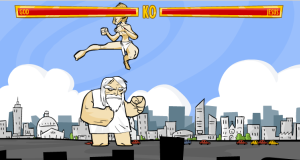 Ich bewerbe ja eher selten Flash-Spiele, aber heute gibt's ne Ausnahme: Faith Fighter, die ultimative Alternative zu Religionskriegen. Im Style von alten Street Fighter-Spielen kann man zwischen verschiedenen religiösen Führern wählen (Gott, Jesus, Buddha, Mohammed, ...) und sich im Straßenkampf messen, natürlich mit den für das Genre üblichen Special Moves.
Ich bewerbe ja eher selten Flash-Spiele, aber heute gibt's ne Ausnahme: Faith Fighter, die ultimative Alternative zu Religionskriegen. Im Style von alten Street Fighter-Spielen kann man zwischen verschiedenen religiösen Führern wählen (Gott, Jesus, Buddha, Mohammed, ...) und sich im Straßenkampf messen, natürlich mit den für das Genre üblichen Special Moves.Das ganze stammt von einer italienischen Gruppe mit Namen »La Molleindustria«, die Computerspiele als politische Ausdrucksform begreift. Operation: Pedopriest von der selben Gruppe hat's schon bis zu einem im Parlament verhandelten Skandal geschafft.
We believe that the explosive slogan that spread quickly after the Anti-WTO demostrations in Seattle, »Don't hate the media, become the media,« applies to this medium.
Leider funktionierte das Spiel im moment weder in gnash noch swfdec (freie Flash-Player), jedoch wies mich ein swfdec-Entwickler darauf hin, dass die EXE-Version des Spiels problemlos mit WINE läuft.
(via telepolis)
Posted by Hanno Böck
in Computer culture, Politics, Retro Games
at
22:28
| Comments (0)
| Trackbacks (0)
Defined tags for this entry: faithfighter, flash, gnash, molleindustria, religion, religionskritik, swfdec, wine
Monday, March 3. 2008
Chemnitzer Linux-Tage 2008
Image by Fabian Fingerle
Ich habe tendenziell wenige, dafür aber gute Vorträge besucht (einen zum Hackerparagraphen und einen über Spam). Videos gibt's wohl leider keine, aber Audioaufnahmen sollten demnächst kommen. Desweiteren war ich aktiv am OpenStreetMap-Stand beteiligt, wir bekamen freundlicherweise bei der Wikipedia ein bißchen Platz. Für die Zukunft sind aber dann eher eigenen OpenStreetMap-Stände angesagt (beispielsweise beim Linux-Infotag in Augsburg).
Auch den Organisatoren sollten wir OpenStreetMap noch näher bringen, so war auf der Seite für die Wegbeschreibung lediglich map24 verlinkt. Zumindest ein alternativer OSM-Link sollte doch obligatorisch sein.
Monday, February 18. 2008
OpenStreetMap-Talk in Karlsruhe
Hatte gestern mal wieder einen OpenStreetMap-Einführungstalk gehalten, diesmal beim Entropia, dem Karlsruher CCC-Ableger.
Vortragstechnisch habe ich diesmal die Folien deutlich reduziert (Download hier als OpenDocument) und den Fokus auf das konkrete Zeigen von Software und Interfaces gelegt.
Für Karlsruher OSM und Geo-Interessierte: Auf der Mailingliste KA-Geo werden lokale Treffen und Aktivitäten koordiniert.
Vortragstechnisch habe ich diesmal die Folien deutlich reduziert (Download hier als OpenDocument) und den Fokus auf das konkrete Zeigen von Software und Interfaces gelegt.
Für Karlsruher OSM und Geo-Interessierte: Auf der Mailingliste KA-Geo werden lokale Treffen und Aktivitäten koordiniert.
Monday, February 4. 2008
Geotagging Images
Recently geotagging of images became some popularity due to some articles on popular newspages. I'm already using geotagged images regularly for my work on openstreetmap.
Geotagging images means that you add some metadata in the EXIF-header (part of JPEG-files) where the image was taken. Future cameras probably will include a gps module and will be able to do this automatically, but with today's hardware we need some extra work. Beside manually adding the coordinates, e. g. by clicking on a map, we can synchronize gpx tracks (a common format for recorded gps data) with our images.
I'm usually recording gpx tracks on my mobile phone with Mobile Trail Explorer (a Java/J2ME-software) and an external bluetooth gps device. Before starting, you should accurately set the clock of both devices (the camera and whatever you use to get gpx data). For my hardware I have to do this manually. The mobile phone (Nokia 6230i) supports timesetting via gsm, but my german mobile phone provider doesn't transport that signal. It's also possible to set the time via bluetooth, but then it's rounded down to minutes (at least with gnokii and gammu, I'm not sure if this is an application bug or a hardware limitation), so this is useless, too.
My camera (Canon IXUS 50) seems to have no way of automatically setting the time.
Now, considering you were out somewhere, made some photos while you had another device recording gpx data. There's a small skript called gpsPhoto that will give your images GPS data:
Now you have images that contain data where they were made. JOSM (an openstreetmap tool to create map data) supports showing the geotagged images, which makes editing openstreetmap much easier (you don't have to write down/remember street names, you can take photos of postboxes, bus stops etc. instead of writing down/setting waypoints with your device).
Beside that, this brings up the question if openstreetmap should get a database of geotagged free images together with tools to show them on the map. While this brings up some privacy issues (if the photos contain private buildings, people, car numbers), even the ones without any privacy implications (nature, public buildings) would be a nice feature: Having a map and always being able to say »show me some photos of that location«.
At the moment, this is probably far beyond of the computer ressources available for a project like osm, but it's worth a thought for the future.
Update: Bernd just told me that MTE doesn't use the phone's timestamp, but the one from the GPS device. This means this method doesn't work if your gps doesn't send a correct timestamp signal.
Geotagging images means that you add some metadata in the EXIF-header (part of JPEG-files) where the image was taken. Future cameras probably will include a gps module and will be able to do this automatically, but with today's hardware we need some extra work. Beside manually adding the coordinates, e. g. by clicking on a map, we can synchronize gpx tracks (a common format for recorded gps data) with our images.
I'm usually recording gpx tracks on my mobile phone with Mobile Trail Explorer (a Java/J2ME-software) and an external bluetooth gps device. Before starting, you should accurately set the clock of both devices (the camera and whatever you use to get gpx data). For my hardware I have to do this manually. The mobile phone (Nokia 6230i) supports timesetting via gsm, but my german mobile phone provider doesn't transport that signal. It's also possible to set the time via bluetooth, but then it's rounded down to minutes (at least with gnokii and gammu, I'm not sure if this is an application bug or a hardware limitation), so this is useless, too.
My camera (Canon IXUS 50) seems to have no way of automatically setting the time.
Now, considering you were out somewhere, made some photos while you had another device recording gpx data. There's a small skript called gpsPhoto that will give your images GPS data:
gpsPhoto.pl --dir [directory of your images] --gpsdir [directory of your gpx files] --timeoffset 0
Now you have images that contain data where they were made. JOSM (an openstreetmap tool to create map data) supports showing the geotagged images, which makes editing openstreetmap much easier (you don't have to write down/remember street names, you can take photos of postboxes, bus stops etc. instead of writing down/setting waypoints with your device).
Beside that, this brings up the question if openstreetmap should get a database of geotagged free images together with tools to show them on the map. While this brings up some privacy issues (if the photos contain private buildings, people, car numbers), even the ones without any privacy implications (nature, public buildings) would be a nice feature: Having a map and always being able to say »show me some photos of that location«.
At the moment, this is probably far beyond of the computer ressources available for a project like osm, but it's worth a thought for the future.
Update: Bernd just told me that MTE doesn't use the phone's timestamp, but the one from the GPS device. This means this method doesn't work if your gps doesn't send a correct timestamp signal.
Monday, January 28. 2008
121 Sterne
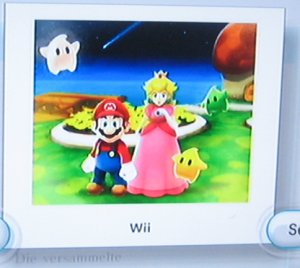 (Achtung Spoiler)
(Achtung Spoiler)Hab jetzt mit Luigi alle 120 Sterne gesammelt. Danach kann man in einem finalen Leven (wobei es kein wirkliches Level ist, man läuft nur durch) noch einen 121. Stern einsammeln. Selbigen ebenso mit Mario.
Nach mehreren berichten im Internet passiert noch etwas wenn man 9999 Sternenteile hat, es sollen sich alle Melonen in Kokosnüsse verwandeln. Hab ich probiert, aber ich seh keinen Unterschied. Vielleicht nur ein Fake, sachdienliche Hinweise (evtl. Howto mit Fotos/Videos) können gerne in den Kommentaren hinterlassen werden.
Savegame zum Download
« previous page
(Page 6 of 20, totaling 289 entries)
» next page
